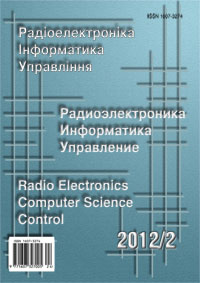H10 WAVE DIFFRACTION ON A JOINT OF REGULAR AND NON-REGULAR WAVEGUIDES WITH DIELECTRIC PLATE OF FINITE LENGHT
DOI:
https://doi.org/10.15588/1607-3274-2012-2-2Keywords:
diffraction, dielectric plate, impedance walls, rectangular waveguide.Abstract
On the basis of the projection method the rigorous solution of the basic wave Н10 diffraction problem on a joint of a regular and non-regular waveguides with a dielectric plate placed parallel to narrow impedance walls is presented. The problem is solved by the method of partial areas. For each of three dedicated areas subject to boundary conditions on the waveguide walls solution of Helmholz equation is put down in the form of cross-section eigenfunction. For a non-regular area including impedance walls and a dielectric plate the solution of Helmholz equation leads to a dispersion equation from which the propagation constants in the area under investigation is determined. Meanwhile, the influence of the impedance walls is considered by means of the Leontovich boundary conditions.Downloads
Published
How to Cite
Issue
Section
License
Copyright (c) 2014 L.M. Logacheva, S.V. Kutsak, V.P. Bondarev, N.Y. Kopyleva

This work is licensed under a Creative Commons Attribution-ShareAlike 4.0 International License.
Creative Commons Licensing Notifications in the Copyright Notices
The journal allows the authors to hold the copyright without restrictions and to retain publishing rights without restrictions.
The journal allows readers to read, download, copy, distribute, print, search, or link to the full texts of its articles.
The journal allows to reuse and remixing of its content, in accordance with a Creative Commons license СС BY -SA.
Authors who publish with this journal agree to the following terms:
-
Authors retain copyright and grant the journal right of first publication with the work simultaneously licensed under a Creative Commons Attribution License CC BY-SA that allows others to share the work with an acknowledgement of the work's authorship and initial publication in this journal.
-
Authors are able to enter into separate, additional contractual arrangements for the non-exclusive distribution of the journal's published version of the work (e.g., post it to an institutional repository or publish it in a book), with an acknowledgement of its initial publication in this journal.
-
Authors are permitted and encouraged to post their work online (e.g., in institutional repositories or on their website) prior to and during the submission process, as it can lead to productive exchanges, as well as earlier and greater citation of published work.






